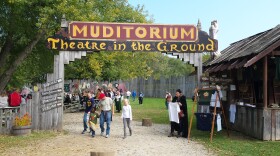Say the word cartoonist and most of us picture someone like Charles Schulz or Garry Trudeau drawing on one of those slanted tables. Those working in the comic arts today have options far beyond pen and ink, but while some cartoonists have fully embraced digital technologies, others have faithfully remained traditional. Community Voices producer Will Davis introduces us to two local artists with very different styles.
The thing about comics is that they’re great when you share them. And I have two for you. In the first panel, we see Jason Young as a boy, sitting in his room, alone.
"I basically learned to read by looking at my brother’s comics when I was a kid," he says."
And in the second panel we see a young Bruce Hughes in the backseat of a car, his parents tossing comic books at him, "For 99 cents they’d buy themselves about a half an hour of peace and quiet."
Jason and Bruce are grown up now and both are cartoonists who make small press comics. Jason makes hand-made books called mini-comics. His stories are usually autobiographical, often droll, and his style? Well, it’s decidedly traditional.
"Every single thing I draw is pen on paper. I just take the original art and take it down to Kinkos or whatever it’s called and just put it face down on the copier and print it out that way and it has an indie, punk rock feel to it that I love."
Jason is part of the DIY, or Do-It-Yourself art movement so he doesn’t rely on others for things like printing or distribution, and the comics he makes deliberately look raw.
"I love books that are a little rough around the edges as opposed to all the Marvel comics that are coming out perfect. You can tell there’s no agenda where they’re trying to sell the actions figures in the movie. They’re just telling their story."
Jason works at Mavericks Cards and Comics in Kettering and its one of about five comic book stores in the Miami Valley. His comics are for sale at Mavericks.
"It would awesome to make money doing this but I think success is just making a good story," he says."
On another shelf at Mavericks, you’ll find Bruce Hughes’s comic books for sale. Bruce is a Sci-fi guy, he’s obsessed with time travel because he says it gives him a chance to go back and fix life’s mistakes.
"I don’t know if I’m making autobiographical comics via Science Fiction but maybe I’m working some things out."
Bruce measures success a little differently than Jason. Bruce is a regular at comic book conventions, or comic-cons, where cartoonists and their fans get together to see and buy and sell each other’s work, and Bruce is there to make money, "But outside of the convention season I measure success by how many pages I get done in a week or a month."
In fact, needing to get more done in less time has caused Bruce away from working traditionally.
"Recently I’ve gone 100% digital," he says. "I looked into that to save time and so far it’s helped so much. I’ve cut things down to 4 to 6 hours per page. That’s 1/3 of what I was doing."
But Bruce admits there can be a bias against cartoonists like him who choose to work digitally, "I’d say among artist digital work is frowned upon. You can’t see the blood, sweat, and tears in it, instantly, and people like to see the fingerprints in something"
Bruce says though that fans often can’t tell, or don’t even care how a comic was made. They just know if they like it. Now Bruce is working on a comic book inspired by the Choose Your Own Adventure books about a boy in a maze. And Jason is creating a full-length graphic novel about the history of Dayton’s NCR.






